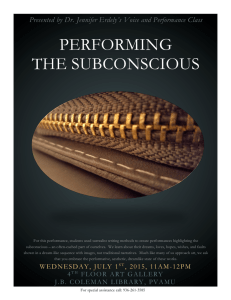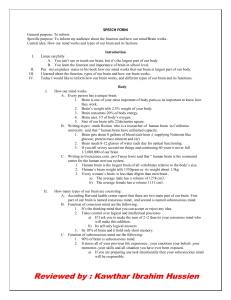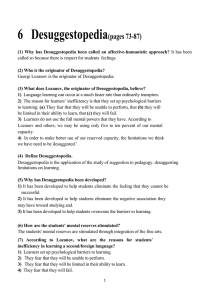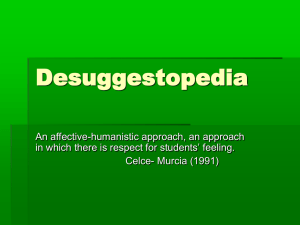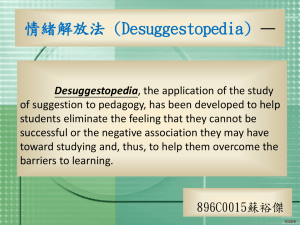Desuggestopedia
advertisement
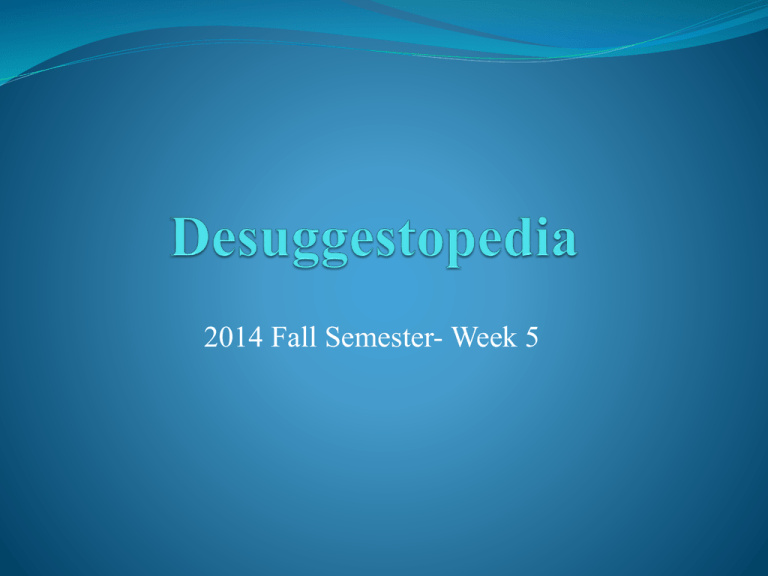
2014 Fall Semester- Week 5 Introduction 1. Goal of instruction: Language learning can occur at a much faster rater if the learners can eliminate the negative association they may have toward studying. 2. Georgi Lozanov: We may be using only five to ten percent of our mental capacity . In order to make better use of our reserve capacity, the limitations we think we have need to be ‘desuggested.’ 3. Desuggestopedia, the application of the study of suggestion to pedagogy, has been developed to help students eliminate the feeling that they can not be successful or help them overcome the barriers of learning. 4. Evelina Gateva: One of the ways the students’ mental reserves are stimulated is through integration of the fine arts. Experience (1) 1. Everything in the classroom is bright and colorful. 2. There are several poster on the wall: travel posters with the scenes of United Kingdom containing some grammatical information. 3. There is also a table with some rhythm instruments on it. Next to them are some hats, masks, and other props. 4. The teacher explained to the students about the new language learning experience in the students’ native language. Experience (2) 5. The students were asked to pick up their new English names and new identities to go along with the new experience . 6. The teacher used pantomime to help the students understand various occupations. 7. The teacher asked yes/no questions in English about the students’ new occupations through her actions. 8. The teacher taught a short English dialogue about how people do for a living to students. 9. After practicing the dialogue with a group, the students introduced themselves to teacher. Experience (3) 10. The teacher distributed and taught a 20-page handout containing a length English dialogue entitled ‘ To want to is to be able to’ with Arabic translation. 11. The teacher put on some music when reading the text and she kept rhythm with the music. 12. The teacher changed the music and read the text again without matching with the music. 13. The teacher encouraged the students to read the text alone before going to bed and after getting up in the morning. Experience (4) 14. In the second class, the teacher wore a hat and played one role and she invited four students as a group to wear hats and played different roles too. 15. The teachers asked students to form different groups and read the text in different ways. 16. The teacher asked new volunteers to played new roles. 17. The teacher asked questions in English about the text, and asked students to translate an Arabic sentence from the text into English. 18. The teacher taught students a children’s alphabet song containing English names and occupations. Experience (5) 19. After the song, the teacher and the students stood up and got in a circle to play an occupation game with throwing a ball. In the third class, the students continued to work with the dialogue with different games. In the following classes, the teacher started a new dialogue with reading, singing, playing, writing, story-telling, etc. in a creative and playful fashion. Thinking about the experience(1) Principles: 1. Learning is facilitated in a cheerful environment. 2. Students can learn from what is present in the environment, even if their attention is not directed to it (‘Peripheral learning’). 3. If students trust and respect the teacher’s authority, they will accept and retain information better. 4. The teacher should recognize that learners bring certain psychological barriers with them should attempt to ‘desuggest’ these. 5. Assuming a new identity enhances students’ feeling of security and allows them to be more open. They feel less inhibited since their performance is really that of a different person. Thinking about the experience (2) 6. The dialog that the students learn contains language they can use immediately. 7. Songs are useful for ‘freeing the speech muscles’ and evoking positive emotions. 8. The teacher should integrate indirect positive suggestions (‘there is no limit to what you can do’) into the learning situation. 9. The teacher should present and explain the grammar and vocabulary, but not dwell on them. The bold print allows the students’ focus to shift from the whole text to the details before they return to the whole text again. The dynamic the parts is important. 10.Fine art provides positive suggestions for students. Thinking about the experience (3) 11. One way that meaning is made clear is through native language translation. 12. Communication takes place on ‘two planes’: on one the linguistic message is encoded; and on the other are factors which influence the linguistic message. On the conscious plane, the learner attends to the language; on the subconscious plane, the music suggests that learning is easy and pleasant. When there is a unity subconscious, learning is enhanced. 13. A calm state, such as one experiences when listening to a concert, is ideal for overcoming psychological barriers and for taking advantage of learning potential. 14. At these times, the distinction between the conscious and the subconscious is most blurred and, therefore, learning can occur. 15. Dramatization is a particularly valuable way of playfully activating the material. Fantasy reduces barriers to learning. Thinking about the experience (4) 16. The fine arts (music, art, and drama) enable suggestions to reach the subconscious. The arts should, therefore, be integrated as much as possible into the teaching process. 17. The teacher should help the students ‘activate’ the material to which they have been exposed. The means of doing this should be varied so as to avoid repetition as much as possible. Novelty aids acquisition. 18. Music and movement reinforce the linguistic material. It is desirable that students achieve a state of ‘infantilization’ so that they will be more open to learning. If they trust the teacher, they will reach this state more easily. 19. In an atmosphere of play, the conscious attention of the learner does not focus on linguistic forms, but rather on using the language. Learning can be fun. 20. Errors are corrected gently, not in a direct, confrontational manner. Review the principles and techniques Answer the 10 questions based on the observation of techniques and principles. 9 techniques are reviewed. Conclusion and Activities Conclusion: Do you think students can learn peripherally? Would it be useful for your students to develop a new target language identity? Would you consider presenting new material with a musical accompaniment? Activities: 1. Check your understanding of Desuggestopedia? 2. Apply what you have understood about the Desuggestopedia. Homework for week 4 1. e-portfolio: Life journal- Copy and paste the principles from the PPT 2. e-portfolio: wiki- peripheral learning 3. e-portfolio: picture- Georgi Lozanov 4. Upload the PPT file to your resource center
